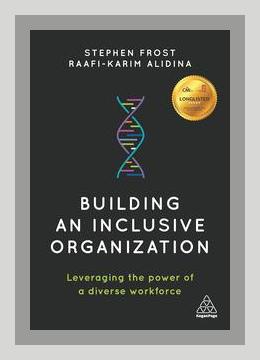Human Resources and Talent ManagementDiversity and Inclusion
Introduction
In Building An Inclusive Organization: Leveraging the Power of a Diverse Workforce, Stephen Frost and Raafi-Karim Alidina present a comprehensive roadmap for organizations aiming to harness the benefits of diversity and inclusion (D&I). The authors argue that a diverse workforce leads to more innovation, creativity, and better decision-making. The book is structured to not only highlight the benefits of diversity but also provide actionable steps to build and sustain an inclusive workplace.
Importance of Diversity and Inclusion
Major Point: Business Case for D&I
The authors highlight how D&I efforts are far more than ethical imperatives; they are also business necessities. Companies that are diverse and inclusive perform better financially, attract better talent, and are better able to serve a diverse customer base.
- Example: McKinsey’s report shows that companies in the top quartile for ethnic and cultural diversity are 33% more likely to outperform on profitability.
Action: Evaluate your company’s current diversity metrics and compare it with market leaders in your industry. Identify gaps and potential benefits of bridging these gaps.
Steps to Building an Inclusive Organization
1. Commitment from Leadership
Major Point: D&I initiatives must start at the leadership level. Without genuine commitment from the top, efforts often fall flat.
- Example: When senior leaders at Sodexo took ownership of D&I, the company saw a 15% increase in employee engagement.
Action: Encourage and facilitate leadership training focused on D&I. Set clear, measurable goals for leaders concerning diversity and inclusion metrics.
2. Reexamining Recruitment Processes
Major Point: Traditional recruitment processes often have inherent biases that can limit diversity.
- Example: Unilever’s use of AI recruitment tools to mitigate unconscious biases led to a more diverse pool of candidates and faster hiring processes.
Action: Implement blind recruitment techniques where possible, anonymizing applications to focus on relevant skills and experience rather than demographic markers.
3. Fostering an Inclusive Culture
Major Point: It’s crucial that existing employees feel included; diversity without inclusion won’t yield benefits.
- Example: At Google, Psychological Safety was prioritized to ensure all team members felt safe to contribute ideas.
Action: Conduct regular surveys to measure inclusivity and act on the feedback to improve company culture. Implement team-building activities that emphasize trust and open communication.
4. Training and Development Programs
Major Point: Continuous learning and development are key to maintaining an inclusive workforce.
- Example: Deloitte’s inclusive leadership program that includes modules on recognizing unconscious biases.
Action: Include mandatory D&I training in your corporate learning programs. Workshops on unconscious bias, cultural competence, and inclusive communication can be highly beneficial.
5. Revising Policies and Practices
Major Point: Even well-intentioned companies can have policies that inadvertently exclude certain groups.
- Example: The implementation of flexible work policies at Microsoft that allowed for better work-life balance, benefiting employees with caring responsibilities.
Action: Review existing policies to ensure they accommodate a diverse range of needs. This might include revising parental leave policies or creating guidelines for flexible work arrangements.
Measuring Success
Major Point: It’s vital to have metrics in place to assess the effectiveness of D&I initiatives.
- Example: IBM uses a Diversity Dashboard that tracks various metrics such as gender ratios, employee engagement scores, and turnover rates among different demographic groups.
Action: Develop a set of Key Performance Indicators (KPIs) related to diversity and inclusion. Regularly review these KPIs and adjust strategies based on the findings.
Overcoming Challenges
1. Resistance to Change
Major Point: There can be significant resistance to D&I initiatives, often stemming from a fear of change.
- Example: Cultural change programs at IBM that included storytelling and sharing personal experiences to break down resistance.
Action: Create forums for open dialogue where employees can voice concerns and ask questions about D&I initiatives. Leaders should also be transparent about the reasons behind and benefits of these changes.
2. Sustaining Momentum
Major Point: Initial enthusiasm can wane, making it difficult to sustain long-term D&I efforts.
- Example: The creation of Employee Resource Groups (ERGs) at companies like Intel, which provide ongoing support and advocacy for underrepresented groups.
Action: Establish ERGs or affinity networks within your organization. These groups can help maintain momentum and provide support for ongoing D&I initiatives.
Conclusion
Stephen Frost and Raafi-Karim Alidina’s Building An Inclusive Organization emphasizes that D&I is not a one-time project but a continuous journey that requires persistent effort, commitment, and strategic action. By following the book’s structured approach and employing the concrete examples and actionable steps provided, organizations can build environments where diversity thrives and inclusiveness is ingrained in the corporate culture, leading to sustained success and innovation.
Summary of Actionable Steps
-
Evaluate Current Diversity Metrics: Assess and compare your organization’s diversity with market leaders.
-
Leadership Training: Facilitate D&I training for senior management and set clear, measurable goals.
-
Revise Recruitment: Implement blind hiring techniques and use AI tools to reduce biases.
-
Inclusive Culture Surveys: Regularly measure inclusivity through surveys and act on feedback.
-
Mandatory D&I Training: Incorporate D&I training in corporate learning programs.
-
Policy Reviews: Ensure existing policies are inclusive and revise them where necessary.
-
Diversity KPIs: Develop and review Key Performance Indicators for D&I.
-
Open Dialogue Forums: Allow employees to voice concerns and ask questions about D&I initiatives.
-
Establish ERGs: Create Employee Resource Groups to support ongoing D&I efforts.
This summary captures the crux of Building An Inclusive Organization: Leveraging the Power of a Diverse Workforce, presenting the authors’ insights, illustrative examples, and the actionable strategies that can be adopted for building a truly inclusive organizational culture.
Human Resources and Talent ManagementDiversity and Inclusion
